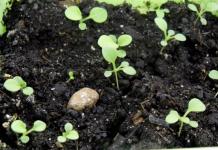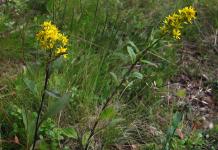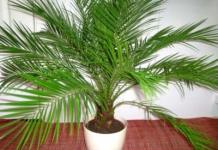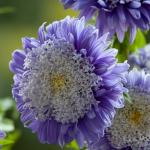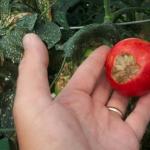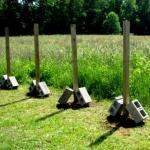Bamboo is the fastest growing plant on Earth. A typical bamboo grows as much as 10 centimeters in one single day. Certain species grow up to a meter per day, or about 1 millimeter every 2 minutes. You can actually see the plant grow right in front of your eyes. In just 5 to 8 years, most varieties of bamboo reach maturity. Compare this to other popular plants that only grow an inch per week. Trees such as oak reach maturity in 120 years.
But when it comes to flowering, bamboo is probably one of the slowest plants in the world. Let's find out about the phenomenon of flowering anyway ...
Bamboo flowering is an intriguing phenomenon because it is a unique and very rare phenomenon in the plant kingdom. Most bamboo stems bloom once every 60 to 130 years. The long flowering intervals remain a mystery to most botanists.
These slow-flowering varieties show another strange behavior - stems produced from a single shoot bloom simultaneously all over the world, regardless of geographic location and climate. Most bamboo is 'subdivision' from a single parent shoot. These divisions have been re-divided over time and spread throughout the world. And although they are now geographically in different locations, they still have the same organization of genetic material. Thus, when bamboo blooms in North America, the same stem in Asia will bloom at about the same time. It looks like plants have an internal clock where the alarm goes off at the same time. This mass flowering phenomenon is called communicated flowering.
According to one hypothesis, mass flowering increases the survival rate of the bamboo population. As soon as the bamboo variety has reached its maximum lifespan, bloomed and produced seeds, the plant dies, and entire forests are erased from the face of the Earth. One theory is that it takes a huge amount of energy to produce a seed, exhausting the bamboo to the point where it actually dies. Another theory suggests that the mother bamboo dies to make room for the bamboo seedlings.
The mass flowering of bamboo attracts predators, mainly rodents. The sudden availability of fruit in vast quantities draws tens of millions of hungry rats into the forest, which feed, grow, and multiply at alarming rates. After they eat the bamboo fruits, the rats start consuming the crops in the neighboring areas. The flowering of bamboo is almost always accompanied by famine and disease in neighboring villages. In northeast India's state of Mizoram, a dire event occurs regularly every 48 to 50 years when the bamboo species of Melocanna baccifera begin to bloom. Such a phenomenon last occurred in 2006 - 2008, in the local language it was called mautam, or "bamboo death".
And now just something interesting about bamboo:
On the western outskirts of the Japanese city of Kyoto is the popular tourist area of Arashiyama. During the Heian period (794-1185), this place was popular with the local nobles, who liked to come here to relax and enjoy the nature views. The cherry blossom season was especially popular.

The famous Sagano Bamboo Forest is located in the same area.
The forest covers an area of 16 square kilometers. A footpath is laid through its dense thickets, the fences of which are woven from fallen bamboo trunks. On a sunny day, when the rays break through the green thicket and the light wind walking in the grove fills the air with amazing sounds, you understand what an amazing place you are.
Bamboo from this forest is still used for the production of various products: dishes, boxes, baskets, mats.
The sound of the wind in Sagano has been recognized by the Japanese government as one of the "hundred sounds of Japan that must be preserved."
The whole area is literally permeated with narrow paths and cozy alleys leading to many ancient temples through numerous bamboo groves and squares.
Right next to the trail are temples and residential buildings - some Kyoto residents are lucky enough to live close to such beauty.

Bamboo is a gigantic tree-like cereal, the tallest grass on the globe, whose relatives are wheat, rye, corn and other representatives of the cereal family known to us. In addition, bamboo today is the fastest growing flowering plant, adding from 70 to 100 centimeters or more per day. Bamboos in Vietnam grow up to two meters per day.
The fact that giant bamboo groves are actually thickets of grass, such meadows of giants, is probably known to almost everyone. But bamboo has many strange properties that science has little studied. Bamboo belongs to the family of cereals, and thus is simply a grass, and this grass can grow up to 40 meters, reaching a girth of 80 centimeters. Bamboo is widespread in all countries of Asia and in both Americas, and where its homeland is unknown.
Wherever it grows, bamboo is extremely valued and used in many industries - both in construction and for the manufacture of furniture and decorative products. But perhaps the most reverent attitude to bamboo in Japan. Along with the more famous sakura and pine, bamboo is a symbol of happiness and purity for the Japanese.
Can you hear the plants grow? Most of the inhabitants of the Earth will answer this question in the negative. But residents of countries with a hot climate, especially Southeast Asia and the Malay Archipelago, will answer that bamboo growth can be heard. The appearance of shoots on the surface of the soil is accompanied by a kind of dull noise, and sometimes crackling. At the beginning of growth, the bamboo stalk grows by more than 1 millimeter per minute. But there are 1440 minutes in a day! What allows bamboo to achieve such a truly cosmic growth rate?
Bundles of pine and bamboo branches in Japan decorate the entrance to homes before the New Year to bring good luck and happiness to the house. Bamboo is considered almost animated in Japan: there is a belief that a young, extremely thin and fragile beauty lives in a thin empty bamboo stem, and if you cut the stem, she will come out. And in the Andaman Islands, it is believed that all mankind appeared, coming into the light from the internodes of bamboo stalks. Take a closer look at its stem, and you will see that it resembles the well-known stem of cereal plants, consisting of thickened nodes in which leaves and internodes are attached.
Bamboo is not only the tallest grass, but also the fastest growing. In the same Japan, watching the growth of bamboo, they set a record - a madake bamboo stem grew by 120 centimeters per day! This means that it grew every hour by 5 centimeters. And, the Japanese assure, if you look at the bamboo during its growth, you can see how it grows with your own eyes. Carefully separate the leaf from the young stem of any cereal and you will see that under the protection of the leaf sheath there is a tender, juicy, sweetish area of the so-called intercalated (intercalary) educational tissue, due to which the stem grows in height. Count the number of nodes. It is in them that the growth of the stem is carried out.
Absolutely mysterious flowering of bamboo. This huge grass blooms once in 25 - 30 years, and some species - even once in a hundred years. Bamboo stems can be of various thicknesses - from 1 to 30 centimeters or more. An interesting fact is that the size of the stem of a future bamboo plant can be determined even before it germinates. To do this, it is enough to rake the ground and, having found a growth bud laid on the rhizome, measure its diameter. The maximum diameter of the kidney will be equal to the maximum thickness of the stem. If the bud is cut lengthwise, then it can be noted that it, like in a telescopic antenna, contains all the nodes of the future stem. The length of the stem will depend on the conditions under which the bud develops. Under favorable conditions, the growth of internodes is fast, and the stem is able to stretch 2 meters per day, under unfavorable conditions, growth slows down. The most rapidly growing is the lowest internodes of bamboo stems.
Among the local population, flowering of bamboo is almost universally considered a bad sign. It is considered a harbinger of either hunger or diseases that rats that have eaten on bamboo fruits can carry. It is not known whether these prophecies come true, but one sad event really awaits these lands - the death of bamboo groves. It is said that in the countries of Southeast Asia this type of execution of especially dangerous criminals was adopted in ancient times. Over areas of bamboo rhizomes, where a large number of buds were located, or over pre-sown seeds ready for germination, the criminal was tied. The rapidly growing stems of bamboo after a while pierced his entire body, like spears, with their growing stems, after which a painful death followed. Looking ahead, let's say that bamboo stems are able to grow through fairly thick layers of asphalt and concrete.
Flowering completes the life span of bamboo, the plant spends too much energy on it, and when it fades, it dies. Moreover, bamboo stalks seem to have an incomprehensible ability to communicate with each other. Bamboos is a collective name for more than 75 (100) genera and 600 species of plants similar in external structure. Their essential feature is the structure of the leaf, along with a linear or narrow oval plate, the leaf in the lower part does not form a sheath covering the stem, as in most cereals, but passes into a short petiole. In addition, the bamboo stem is able to branch. These plants are not only inhabitants of tropical regions, there are bamboos that also grow here on Sakhalin Island. Among bamboos, climbing and climbing forms are known.

Because if bamboo blooms, then, as if by agreement, the whole grove blooms, no matter how big it is, or even several groves nearby. Bamboo growth is limited. Most of them grow within 30-45 days, and the growth of the stems goes on continuously throughout the day, while in most trees the shoots grow for about 1 month a year at an average rate of 0.6 mm per day.
Therefore, flowering sometimes causes the death of bamboo over a large area. So, for example, it happened once in Europe, where bamboo was grown. The stems of certain types of bamboo in such a short period of growth reach a height of 30, sometimes 46 meters, a stem diameter of 25-30 centimeters. There is evidence that the length of the stem of a bamboo growing on the island of Java reaches 51 meters.
And in China, the flowering and death of bamboo caused the giant panda, which eats only bamboo, to die of starvation. Occasionally, tall grass plantations can recover from flowering from strong roots in the same spot, but this takes several years. The wood of the stem is initially relatively soft, after 2-3 years it matures, acquiring extraordinary strength, at the end of the 3rd year it is usually cut off, leaving younger shoots to ripen. Every year, from 9 to 45 thousand stems weighing from 10 to 38 tons are cut from 1 hectare of plantations.
Due to the fact that bamboo blooms so rarely, little is known about its flowering. It remains unclear what caused such a periodicity, why bamboo has such a slow life cycle. Maturity, that is, the ability to bloom and bear fruit, some types of bamboo reach in 28-60 years. Then the bamboo begins to branch, form a crown of lanceolate leaves and bloom. Flowering and fruiting usually last 2-3 seasons, and sometimes 9 years. At this time, a huge amount of nutrients stored in the rhizomes is completely wasted, and the plant dies. Botanists call such plants monocarpics - flowering and fruiting once in a lifetime, after which they die. Flowering periods vary between species of bamboo, but the most established are cycles of 33, 66 and 120 years. Strictly through these periods, bamboo dies, developing huge flowering shoots instead of the usual ones.
Clickable 1920 px

Look at the prettiest, and here are some. And it also happens The original article is on the website InfoGlaz.rf Link to the article from which this copy is made -
Bamboo is a hardy evergreen tropical plant from the Cereal family, which is considered to be the birthplace of East Asia.
Bamboo is distinguished by a knotted golden-straw stem with numerous leaves at the top. As a rule, it reaches a height of 25 to 40 meters and is the tallest grass among all representatives of this family (wheat, corn and rye). At the same time, bamboo has a very high growth rate and some of its species grow from 40 to 100 cm per day.
Within three years, the young trunk becomes stiff. Bamboo trunks are widely used for construction and as a finishing material, musical instruments are made from it and used for paper production.
Bamboo is distinguished by amazing properties - it is not afraid of moisture, sun, or temperature changes. In the East, it is considered a symbol of indomitable strength and energy, since its sprouts can easily pierce even a stone. Buddhists regard it as a sacred plant, personifying longevity, spiritual truth, constancy, grace, lasting friendship and blooming old age.
Composition of bamboo
Bamboo contains 90% water. It is rich in protein - an average of 1.49 to 4.04 g per 100 g of fresh shoots. In addition, it contains eight essential essential amino acids.
100 g of bamboo shoots contains:
- 90.86 g water;
- 2.65 g proteins;
- 0.49 g fat;
- 0.58 g fiber;
- 0.88 g of ash.
Bamboo is rich in vitamins. Its shoots contain vitamins A, B6, E, thiamine, niacin, riboflavin, folic and pantothenic acids. They are also rich in minerals, including calcium, phosphorus, magnesium, potassium, manganese, sodium, zinc, copper, selenium and iron.
The calorie content of bamboo is 20 kcal per 100 g of shoots.
Useful properties of bamboo
Young bamboo shoots are not only tasty, but also rich in nutrients. They are among the top five most popular healthy foods in the world.
The main properties of bamboo were recorded in an ancient pharmaceutical text from the Ming Dynasty (1368-1644): “It is cool, sweet, non-toxic, quenches thirst, improves blood circulation, adds Qi energy, and can be used daily.”
In Asian countries, the anti-inflammatory and restorative properties of bamboo, due to the presence of a strong antiseptic in its fibers, are often used for colds and SARS, as well as for allergies and asthma.
Bamboo is also one of the few plants characterized by a large amount of silicic acid, which:
- Helps strengthen hair and nails;
- Beneficial effect on the skin;
- It has a calming effect in depressive states.
Bamboo is effective for peptic ulcers, digestive disorders and diarrhea. In Asian countries, it is also used in the treatment of diseases such as jaundice, tuberculosis, fever and dysentery.
Bamboo extract strengthens the walls of blood vessels, improves blood circulation in tissues, reduces capillary permeability and increases their elasticity and tone.
For medicinal purposes, not only bamboo shoots are used, but also other parts of this amazing plant:
- Bamboo roots are used as a general tonic;
- With antipyretic and expectorant properties, bamboo leaves are considered a good cough medicine;
- Bamboo juice is used as a remedy for apoplexy and epilepsy.
Health benefits of bamboo shoots
Bamboo shoots are more of an exotic food, since they are most widely used in Asian countries. However, the beneficial properties of bamboo are gradually finding their fans in Western countries.
Bamboo promotes gradual weight loss. Due to its balanced nutritional content, it is considered an ideal food for those who want to lose weight without feeling constantly hungry. Dietary fiber, included in large quantities in bamboo, is necessary for digestion and improving intestinal motility. In order to lose weight faster, it is recommended to eat young shoots for dinner. Bamboo's low calorie content and low carbohydrate content make it suitable for use in a variety of plant-based diets.
The vitamins, minerals, and antioxidants found in bamboo shoots help boost the immune system.
According to many studies conducted in India and Asian countries, the benefits of bamboo for the prevention of heart disease have been proven, as it helps to dissolve cholesterol. Due to its low fat content and low calorie content, bamboo also has a beneficial effect on intestinal function.
Many studies have confirmed the anti-inflammatory and analgesic properties of bamboo, which allows it to be used externally in the treatment of wounds and ulcers.
Application of bamboo
A decoction of bamboo shoots is used in Asian countries to treat respiratory diseases. As a rule, to obtain a decoction, the shoots should be boiled twice, first 5, then 10 minutes. The resulting decoction can be taken with honey.
Traditional Chinese medicine believes that bamboo shoots have a rather rare property - to have a stimulating effect on the muscles of the uterus. Bamboo leaves are also used for indigestion and as an anthelmintic.
Bamboo shoots are used in cooking to make various dishes. As a rule, they are pre-boiled, after which they are eaten with butter and soy sauce. They can also be added to soups, sauces, pickles and salads.

Fresh bamboo shoots keep up to two weeks in a cool place and away from sunlight. Improper storage can result in a bitter taste. In order to preserve the beneficial properties of bamboo for a longer time, it is usually preserved.
In Japan, they also eat bamboo seeds, which vaguely resemble oats.
Contraindications and harm of bamboo
There are no contraindications to the use of bamboo for food. However, when cooking with bamboo shoots, it should be taken into account that young shoots contain a poisonous cyanogenic glycoside, which, however, is quickly destroyed during cooking.
Video from YouTube on the topic of the article:
Bamboo is the tallest and most mysterious evergreen in the world. A plant that is not a tree is able to withstand gusts of wind.
For Asian countries, it means a lot. According to their legends, it was bamboo that gave rise to life for all people on earth. We will tell you how to grow and care for bamboo, as well as at what speed it grows.
Bamboos belong to the grass family and form a separate subfamily. This includes almost 50 genera and 1000 species. All of them differ in shape, size, but they have one thing in common - their light and durable trunk. It is for this trunk that the plant is so valued.
Photo of growing in a pot at home
In many species, the stem - straw - becomes woody, but there are also annuals. Among them there are also herbs with petiolate leaves or flowers with stamens. Basically, plants live in the tropics. But you can often find them in subtropical or even temperate zones. Some species grow high in the mountains. Some of them can be planted in pots, some in open ground.
Let's consider some of them:
The most unpretentious plant is Kuril saza. It can be used as a regular grass lawn.
Low grasses - a naked grass and a multi-branch - in combination with others form beautiful clearings in gardens and household plots.
Dwarf bamboo has a very elegant appearance, it reaches a height of only up to 40 cm, and is used as an ornamental grass.
Phyllostachys and fargesia grow up to 4-6 m. Phyllostachys grows only in warm climates. It grows quite quickly, so protective barriers are placed in the gardens for it.
Fargesia Muriel, on the contrary, feels quite comfortable in harsh conditions. Freezing in winter to the level of snow cover, the next year it gives new shoulder straps, stronger.
Frosts up to 10 degrees are able to withstand and the mabuza is polysyllabic. The plant forms a low dense bush with thin stems and bluish leaves. Used to decorate front gardens, courtyards, balconies.
This is only the smallest part of the huge family of this plant.
Flowering and reproduction
To meet flowering bamboo is a rarity in nature. The plant is monocarpic. This means that they bloom once in a lifetime, and then simply die. Before flowering, woody species can grow for several decades. The growth period can even last up to 100 years. Plant flowers are mostly small, hidden in the axils, almost invisible at first sight. But there are species with large paniculate inflorescences.

Plants are also propagated by:
bamboo care

In winter, plants should be kept in a light, slightly cool room. In summer it develops well in an open sunny place. Watering in the summer should be plentiful, in winter - moderately.
Transplant plants in the spring. Potted plants need to be repotted once a year as the root system develops very fast growing. The tubers are transplanted every 2-4 years. It is best to take a mixture of turf, leaf, peat soil and sand for planting.
Approximately 20% of the bamboo is cut annually to rejuvenate the plantation.
Usage
The fresh stem is full of water. The annual stem is almost useless for practical purposes. As the stem matures, the water in the stem is replaced by fiber. The best bamboo is considered to be harvested between the ages of three and seven years. These plants are used for:

From adult plants, you can build houses, bridges, create small items: baskets, hats.
While watching the video, you will learn about bamboo.
Of course, people are enjoying the properties of bamboo to soar to meet their goals. And this is not always done for the benefit of the person himself. For example, the high growth properties of grass have long been used to execute a person
Attention, super FLY!
Bamboo is an evergreen perennial plant that belongs to the grass family and is common in the tropical regions of Asia.
This plant is known as a durable building material and as the fastest growing plant on the planet.
For 2000 years, bamboo has been widely used as a material for building bridges, dwellings, watercraft, household utensils and musical instruments. The omniscient Chinese made tenths of a millimeter thick needles for their ancient medical operations from bamboo, as well as plumbing, which was used until the 3rd century BC. With the help of such a pipeline, they transported salt water from salt springs to Tsu-Liu-Ching (Suchian Province).
Bamboo stems can grow up to 40 meters. At the same time, the growth rate of the plant can reach 75 cm per day.
A group of bamboo in a certain area blooms only once every few decades. At the same time, bamboo of the same species blooms at the same time, regardless of the place of growth.
Another mystery is connected with the fruiting of bamboo. Plants of the same group, which originated from one "parent", at the age of 33 to 66 years, bloom and die after fruiting. Such a massive death of bamboo groves has an extremely negative impact on both the lives of people and the lives of animals, such as giant pandas from China.
Bamboo groves are actually thickets of giant grass, like a plant belongs to the grass family.
Another feature of bamboo is the different diameter of the trunks, which depends on humidity, soil composition and species. Therefore, it is very difficult to collect a large number of shoots of the same diameter. For the transfer of trunks, ingenious knots are used to group shoots of different diameters and thicknesses. In modern times, special adhesives and even fittings like bolts are sometimes used.
In countries where bamboo grows, this plant is treated with respect. Bamboo is used not only for construction, but also for the manufacture of furniture and crafts. bamboo is considered a symbol of purity and happiness.
Some varieties of bamboo produce a special oil, tabashir, which is used, for example, as a cure for asthma, coughs, and even as an aphrodisiac in southwest Asia. And from the heated bamboo, a combustible resin is isolated, which is used in lanterns. By the way, the first light bulb, made in 1880 by Thomas Edison, used specially processed bamboo fiber as a filament.
Some structures made from bamboo have survived for thousands of years. The closed bamboo bridge in An-Lan, thrown over the Ming River (southwestern China), was built in the 3rd century AD. Its length is 320 meters, it is a suspension bridge, the supporting structures of which are 15 bamboo cables, 5 centimeters in diameter. He is still in good condition, twice a year he undergoes prophylaxis.
Even in 1905 China had drilling stations made entirely of bamboo. The height of these structures was 75 meters, and they were built in 220 AD - almost 1800 years ago! That's durability...
Another advantage of bamboo is that if you cut down its trunk, a new one will begin to grow in this place. bamboo roots very branched, and start up new shoots at a distance of up to 6 meters from the center. There are about 180 central roots per hectare of bamboo forest that have supported this entire plantation for decades. Bamboo roots are also highly resistant to erosion, landslides and even earthquakes due to their exceptional strength and vitality.
The structure of bamboo wood is similar to oak wood. However, its strength, according to studies by French scientists, is two and a half times higher than the strength of oak wood.
In financial terms, the cost of building a bamboo house is 8 times less than building the same size modern concrete building. But in the event of an earthquake, the concrete building will collapse much sooner. Therefore, bamboo is widely used for building houses in our time in southwest Asia, Africa and Latin America.
There are over a thousand types of bamboo. Some of them grow in severe cold conditions in the mountains, at an air temperature of -24 degrees Celsius, at altitudes of about 5000 meters above sea level. Argentinean and Chilean species of bamboo, on the contrary, grow in conditions of high humidity and unbearable temperature for humans.
The main bamboo producers in the world are Pakistan, Bangladesh, Thailand, Malaysia, Indonesia, China, the Philippines, Sri Lanka, Tanzania, Kenya, Costa Rica and Brazil. All of them grow up to 10 million tons of bamboo per year.
The bamboo growth record was recorded in Japan. A stalk of madake bamboo grew 5 cm in an hour, increasing by 120 cm in a day.
Bamboo used not only in construction. Sugar is extracted from this plant, and young shoots, roots and seeds are eaten.
There are more than a thousand types of bamboo in the world. At the same time, some plants can tolerate both severe sub-zero temperatures and live at altitudes of about 5000 m above sea level, as well as conditions of high humidity and high temperature.
The root system of bamboo is distinguished by its strength and vitality. On one hectare of a bamboo grove, only 180 central roots can be located, supporting all plants.
The oldest bamboo structure that has survived to this day is the 320-meter-long bamboo suspension bridge at An-Lan, spanning the Ming River in southwestern China. This bridge was built in the 3rd century AD.
To acquire such an unusual indoor plant as bamboo, only experienced connoisseurs of the exotic decide, for whom nothing is impossible. However, a novice grower can also handle bamboo. A little care and concern - and the overseas handsome man will settle in the home flower collection for a long time.
Where and how does bamboo grow?
Bamboo or Bambusa in Latin belongs to a large family of cereals. The bamboo genus includes more than 600 species of plants, which are giant grasses with woody stems. In the family of cereals, there are several more genera, and in them - plant species, also called bamboo. These are leaf-bearers, multi-branchers and saz.
Among flower growers, "home bamboo", which is also called "happiness bamboo" or "happy bamboo", is very popular. In fact, this is Sander's dracaena, belonging to the dracaena family. This plant can be recognized by the spiral stems that are artificially formed with the help of special devices.
Interestingly, in the bosom of nature, real bamboo grows incredibly fast - up to 2 meters per day. Its trunk is a giant straw with nodes and internodes. While in other plants only the upper parts grow, in bamboo, at the time of growth, all internodes are elongated at once. This feature explains the rapid growth. Due to its size, bamboo is sometimes called a tree. For example, Burmese bamboo, which grows in India, reaches 40 meters in height.
Bamboo is native to the tropical and subtropical forests of Southeast Asia, Australia and America. Under natural conditions, it grows in whole groves on the edges, clearings and along the banks of rivers. Bamboo reaches its maximum growth in one season, and then its height remains unchanged for several decades. The stems become very coarse, become very strong and acquire great value. About 600 uses of this plant are known.
Bamboo has powerful and rapidly developing rhizomes. Starting to grow in a fairly spacious area, in a few years it can fill the entire area with its roots. It is extremely difficult to get it out. From a small piece of root, bamboo can quickly turn back into a giant grass. The locals consider it a weed.
It blooms only once in a lifetime, releasing small paniculate inflorescences, and after the seeds ripen, it ceases to exist. In southern countries, after flowering, entire bamboo groves die out, growing for many years.
Residents of southern countries have long attributed miraculous properties to the plant. In China, bamboo brings health and longevity to the home, in India it is considered a symbol of friendship, in the Philippines it gives prosperity and happiness. And scientists have proven that bamboo purifies the air of harmful impurities and improves the microclimate in the house.
Bamboo has very decorative leaves that have a narrow lanceolate shape. The green foliage forms beautiful spreading greens as it grows. No less decorative and unusual stems of bamboo in the form of hollow green or yellow tubules.
Types of decorative bamboo for home breeding
At home, only low forms are grown. The most common decorative types are:
- Brilliant bamboo or Sasa nitida is a plant with purple stems reaching 3 m in length. It is grown as an indoor tub plant in home greenhouses.
- multi-layered or polysyllabic, in Latin Bambusa multiplex - a tall species up to 4 m in height. Grows in rooms with high ceilings.
- bluish or in Latin Bambusa glaucescens is a dwarf species, reaching no more than 40 cm in height. Grown as a pot culture.
- variegated or Arundinaria fortunei is a dwarf form with variegated leaves adorned with cream and white stripes. It grows no more than 1 m in height.
- kumasasa, in Latin Shibataea kumasasa - an interesting form with zigzag flattened stems. Grows as a dwarf compact bush.
- Muriel or Shibataea muriliae is a plant with yellow stems growing up to 3 m in length.
- Bamboo of happiness or Dracaena Sander, in Latin Dracaena sanderiana, is a spectacular plant of the Dracaena family with spiral shoots.

growth conditions
Indoor bamboo, despite its origin, is a very unpretentious plant. A bright, not very hot and well-ventilated room is the main condition for successful growth.
Bamboo can be cut into different shapes by pruning. If you cut off the tops of the plant, it will stop its growth and begin to intensively grow leaves, thus forming a variety of bizarre shapes. Cut the stems should be 5 cm above the node.
Valentina Kravchenko, expert
With proper care, bamboo grows rapidly, actively develops and reproduces well. Dried leaves and shoots are quickly replaced by new ones, and the root system is actively growing.
Growing bamboo at home
Most often, bamboo is grown from a small young plant purchased at a flower shop. When buying, you should carefully inspect the stem for the presence of pests or diseases. Do not buy a diseased plant.
If, nevertheless, bamboo is in a deplorable state in your house, you need to treat it in order to save the plant and not infect the rest of the indoor flowers. After purchase, you need to transplant it into a new container with the right substrate as soon as possible, as very often store plants are in containers with temporary soil, or the soil in the container can be infested with insects.
It is very important that the container is wide enough - about 2 times wider than the root system of the plant. After a while, when the bamboo grows and takes up all the free space in the pot, it is necessary to transplant it into a larger container.
In the case where space does not allow much increase in the size of the pot, you can stop the growth of bamboo by cutting its roots by a third, filling the container with fresh earth and placing it back in the old pot. If you do not transplant and do not cut the roots, the plant will wither and drop its leaves from crowding in a pot. In summer, it is very useful to take out bamboo to fresh air - to the balcony or to the garden.
How to plant bamboo in a pot
The capacity for transplantation should be chosen not very deep and wide, always with drainage holes. At the bottom of the pot, it is necessary to pour a layer of drainage about 3 cm high in the form of expanded clay or pebbles - this is a very important condition for the health of the roots.
Bamboo is transplanted into nutrient soil and watered well. It does not hurt to keep the plant in partial shade for the first few days after transplanting. Watering a young plant should be plentiful, but avoiding waterlogging of the soil. Young plants are transplanted every spring, and 3-year-olds and older - every 2 or 3 years.

Growing bamboo in water
Most often, "happiness bamboo" or Sander's dracaena is grown in water. This plant thrives well in a humid environment and can grow up to 1m tall. Real bamboo can also grow in water. Several "reeds" are placed in a ceramic or glass container with water and pebbles or glass beads at the bottom, for which the plant clings to the roots.
In order for the plant to feel good, it is necessary to provide it with melt or rain water. Bamboo will not tolerate tap water. Melt water can be easily prepared by yourself. To do this, fill a plastic bottle with ordinary tap water and place it in the freezer for two days. By defrosting the bottle at room temperature, you will get melted water.
Once every two or three months, it is recommended to feed the plant with a special mineral fertilizer. The water in the vessel should be changed once a week. Pebbles should be washed and rinsed with boiling water in a timely manner. It is useful to put a few activated charcoal tablets in the water.
Reproduction of bamboo at home
Bamboo is propagated in the following ways:
- The division of the bush. To do this, you need to unearth the roots and separate from them a strong root process with two or three nodules and thin roots. A new plant must be planted in a container of suitable size filled with nutrient soil. The presence of drainage at the bottom and moderate watering are the conditions for the successful rooting of young bamboo.
- Lateral shoots that appear at the base of the bush. It is necessary to carefully separate the shoot, plant it in a container with earth and wait for rooting.
- Seeds. If you order bamboo seeds by mail, you can try to grow it yourself. However, this is a very complex and unpredictable process. Before sowing, it is advisable to soak the seeds in a solution of a growth stimulator or potassium permanganate. You need to sow in bowls with drainage, fertile soil and drainage holes in the bottom. Seeds should not be located very deep underground. Germination can take up to 3 months. Can also be grown from seed using hydroponics.

home bamboo care
Soil and lighting requirements
The soil for "lucky bamboo" or Sander's dracaena should be loose and permeable. You can use a ready-made mixture for dracaena.
The soil for real bamboo should be heavy and nutritious. It is recommended to prepare the soil yourself from the following components: 1 share of peat, sand, humus, leaves and 2 shares of clay soil with turf.
Bamboo is a big light lover. The plant is able to survive in the sun, but prefers western or eastern windows. If placed on a south window, the leaves of the plant will fade and lose their decorative effect. On the north window, it suffers from a lack of light, does not bush well and loses leaves. In the summer, it is advisable to take bamboo out to the balcony, veranda or garden. The plant loves fresh air.
Watering and feeding
Bamboo should be watered abundantly in summer, while moderately in winter. It is important to ensure that the earthen ball does not dry out. It should be remembered that waterlogging is very dangerous for the plant, so the topsoil should dry out between waterings.
Bamboo can itself declare its need for watering. If its leaves begin to curl, then there is not enough moisture, but if the foliage sags, this is a signal of waterlogging the soil.
Occasionally, bamboo is sprayed with a fine spray method, which increases the humidity in the room. It also does not hurt to regularly wipe the leaves of the plant with a damp cloth.
It is recommended to feed bamboo with fertilizers rich in nitrogen and phosphorus. Balanced mineral fertilizers are well suited. You can apply fertilizers such as "Ideal", "Rainbow" or "Giant". You need to feed from April to August 2 times a month.
Diseases and pests of homemade bamboo
Bamboo diseases are associated only with improper care. Spotting and “rust” may appear on its stems and leaves. This means that the plant is affected by a fungal disease. It is necessary to treat diseased bamboo with fungicides and establish proper care, as well as regular airing.
Bamboo is not too prone to pest damage, but if poorly cared for, it can suffer from spider mites and aphids. If insects are found, remove them with a soapy sponge. If any part of the stem is already affected, it is necessary to cut it off, and treat the remaining healthy parts of the plant with an insecticide. Pest attack prevention is the correct watering regimen and regular inspection of the plant.
As you can see, such an exotic plant as bamboo is not so difficult to "tame". The most important thing is to choose the right type, understand the intricacies of care and provide the plant with conditions close to natural.
Have you tried growing your own bamboo grove in a pot? What difficulties did you encounter?


